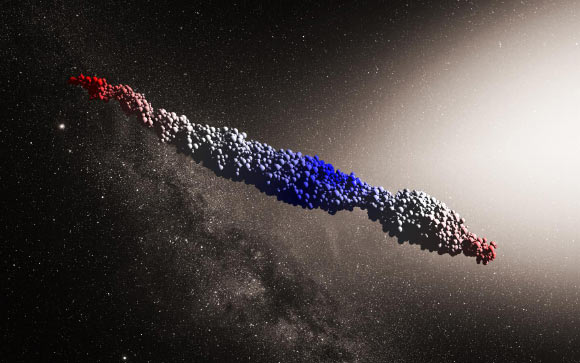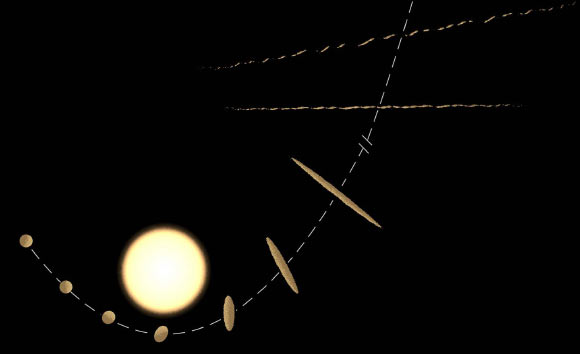A due of researchers used numerical simulations to show that interstellar objects like ‘Oumuamua, a fast moving, cigar-shaped object of extrasolar origin discovered on October 19, 2017 by the Pan-STARRS 1 telescope in Hawai’i, can be produced through tidal fragmentation and ejected during close encounters of their parent bodies with their host stars.

An ‘Oumuamua-like object produced by a simulation of the tidal disruption scenario. Image credit: Y. Zhang / NAOC / M. Kornmesser / ESO.
“‘Oumuamua is absolutely nothing like anything else in our Solar System,” said first author Dr. Yun Zhang, a researcher at the National Astronomical Observatories, the Chinese Academy of Sciences.
“Its dry surface, unusually elongated shape, and puzzling motion even drove some scientists to wonder if it was an alien probe.”
“It is really a mysterious object, but some signs, like its colors and the absence of radio emission, point to ‘Oumuamua being a natural object.”
“Our objective is to come up with a comprehensive scenario, based on well understood physical principles, to piece together all the tantalizing clues,” added University of California, Santa Cruz’s Professor Douglas Lin, co-author of the study.
Astronomers had expected that the first interstellar object they detected would be an icy body like a comet.
Icy objects like those populating the Oort cloud evolve at very large distances from their host stars, are rich in volatiles, and are often tossed out of their host systems by gravitational interactions. They are also highly visible due to the sublimation of volatile compounds, which creates a comet’s coma when it is warmed by the Sun.
‘Oumuamua’s dry appearance, however, is similar to rocky bodies like the Solar System’s asteroids, indicating a different ejection scenario.
Other researchers have calculated that there must be an extremely large population of ‘Oumuamua-like interstellar objects.
“The discovery of ‘Oumuamua implies that the population of rocky interstellar objects is much larger than we previously thought,” Dr. Zhang said.
“On average, each planetary system should eject in total about a hundred trillion objects like ‘Oumuamua. We need to construct a very common scenario to produce this kind of object.”
When a smaller body passes very close to a much bigger one, tidal forces of the larger body can tear the smaller one apart, as happened to comet Shoemaker-Levy 9 when it came close to Jupiter.
The tidal disruption processes can eject some debris into interstellar space, which has been suggested as a possible origin for ‘Oumuamua.
But whether such a process could explain ‘Oumuamua’s puzzling characteristics remained highly uncertain.

This illustration shows the tidal disruption process that can give rise to ‘Oumuamua-like objects. Image credit: Y. Zhang / NAOC.
The study authors ran high-resolution computer simulations to model the structural dynamics of an object flying close by a star.
They found that if the object comes close enough to the star, the star can tear it into extremely elongated fragments that are then ejected into the interstellar space.
“The elongated shape is more compelling when we considered the variation of material strength during the stellar encounter. The ratio of long axis to short axis can be even larger than ten to one,” Dr. Zhang said.
The team’s thermal modeling showed that the surface of fragments resulting from the disruption of the initial body would melt at a very short distance from the star and recondense at greater distances, thereby forming a cohesive crust that would ensure the structural stability of the elongated shape.
“Heat diffusion during the stellar tidal disruption process also consumes large amounts of volatiles, which not only explains ‘Oumuamua’s surface colors and the absence of visible coma, but also elucidates the inferred dryness of the interstellar population,” Dr. Zhang said.
“Nevertheless, some high-sublimation-temperature volatiles buried under the surface, like water ice, can remain in a condensed form.”
Observations of ‘Oumuamua showed no cometary activity, and only water ice is a possible outgassing source to account for its non-gravitational motion.
If ‘Oumuamua was produced and ejected by the team’s scenario, plenty of residual water ice could be activated during its passage through the Solar System.
The resulting outgassing would cause accelerations that match ‘Oumuamua’s comet-like trajectory.
“The tidal fragmentation scenario not only provides a way to form one single ‘Oumuamua, but also accounts for the vast population of asteroid-like interstellar objects,” Dr. Zhang said.
The calculations demonstrate the efficiency of tidal forces in producing this kind of object.
Possible progenitors, including long-period comets, debris disks, and even super-Earths, could be transformed into ‘Oumuamua-size pieces during stellar encounters.
This work also supports estimates of a large population of ‘Oumuamua-like interstellar objects.
Since these objects may pass through the domains of habitable zones, the possibility that they could transport matter capable of generating life — called panspermia — cannot be ruled out.
“This is a very new field. These interstellar objects could provide critical clues about how planetary systems form and evolve,” Dr. Zhang said.
“‘Oumuamua is just the tip of the iceberg. We anticipate many more interstellar visitors with similar traits will be discovered by future observation with the forthcoming Vera C. Rubin Observatory,” Professor Lin said.
The team’s work was published in the journal Nature Astronomy.
_____
Y. Zhang & D.N.C. Lin. Tidal fragmentation as the origin of 1I/2017 U1 (‘Oumuamua). Nat Astron, published online April 13, 2020; doi: 10.1038/s41550-020-1065-8







